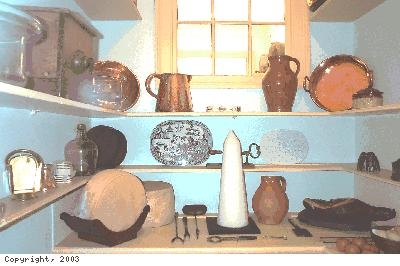The Georgian House
Larder
This larder is a large walk-in cupboard between the kitchen and laundry. It was a place to store food for immediate use. There are storage areas under the road outside the house, which can be accessed from the kitchen level of the house.
Many foods were bought on a daily basis and delivered to the door. Large quantities of flour would be needed to make bread, a basic food accompanying all meals. Mice and rats, as well as cockroaches and weevils, were attracted to any foods not carefully stored.
The tall white cone in the centre of the picture is sugar. In the 18th century rich people bought their sugar as a cone or loaf. It came in this shape because of the way it was made: hot liquid sugar was left to go hard (‘crystalise’) in cone-shaped pottery moulds. To use the sugar, pieces were broken off the loaf. Sharp sugar nippers were used to break pieces of sugar into small lumps. The pieces would be ground into a powder or dissolved in liquid for use in baking and cooking. People who could not afford a whole sugar loaf would buy a piece from the grocer.
There were no refrigerators so it was difficult to stop food from going bad. To make it keep longer, fish could be bought salted or dried. Meat could also be salted and dried or pickled in salt water (brine).
Spices were an expensive luxury brought into Britain from places like Indonesia and India. Spices were used in wealthy households like that of the Pinney’s to disguise or change the flavour of meat or fish, especially when it had been preserved by salting or drying.

 The layout of the Georgian House
The layout of the Georgian House Drawing Room
Drawing Room Dining Room
Dining Room Study
Study Library
Library Bedroom
Bedroom Kitchen
Kitchen Laundry
Laundry Larder
Larder Housekeepers Room
Housekeepers Room John Pinney
John Pinney

